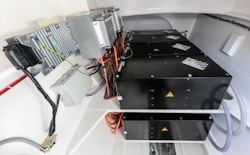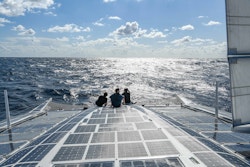The short-term energy storage of Energy Observer
Energy Observer chose complementary storage systems: short-term storage in a set of Li-Ion batteries, and eight hydrogen tanks for long-term storage.
Battery storage
The main set of batteries feed the electric motors via the 400-volt network. The capacity of 112 kWh is optimised: it’s only 2.5 times more than the type of battery used for an electric car like Renault’s Zoe!
Another set of 18 kWh batteries powers the 24-volt low-voltage network and every-day facilities on board: electronic navigation, on-board computer, lighting, comfort, security, etc. Great care was taken to make sure the two networks do not interfere with each other. For example, the engineers had to add several power converters to an even supply of electricity from the different sources (photovoltaic panels, wind turbines, etc.). Lastly, all the wiring was simplified to reduce on-line power loss, and to reduce the size of energy storage and supply systems.

Energy Observer's Double battery storage
Weight – a Hefty problem
Le double stockage batteries / hydrogène à bord d’Energy Observer illustre la complémentarité des stockages ainsi que la répartition des usages.

The double storage of batteries and hydrogen aboard the Energy Observer demonstrates the complementarity of storage and the distribution of use.
The batteries provide short term immediate power, whilst the hydrogen provides long-term autonomy. But above all, the Energy Observer demonstrates the immense advantage that hydrogen has over batteries. The battery set weighs 1,400 kg for 112 kWh, whereas the hydrogen storage and fuel cell together weigh a total of 1,700 kg for 1,000 kWh. This means 1 kWh weighs 12.5 kg when stored in batteries, and only 1.7 kg when stored as hydrogen.
In other words, for equal weight, hydrogen storage contains 7.35 times more power than the batteries, which is a considerable advantage for mobility, whether it be on the sea, land or in the air.